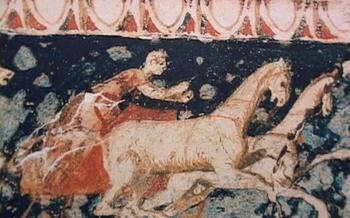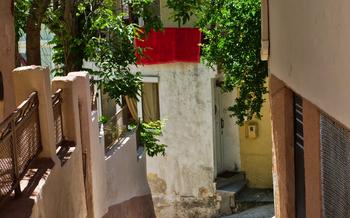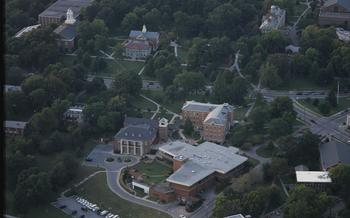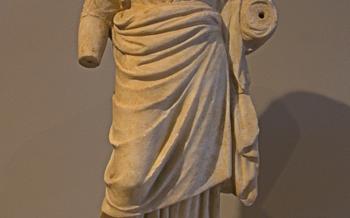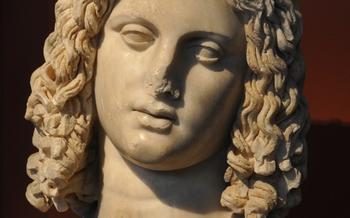
Thessaloniki Archaeological Sites Museum
- A Journey Through Ancient Treasures: Unveiling the Thessaloniki Archaeological Sites Museum
- Stepping into the Past: A Historical Overview of the Museum
- A Glimpse into Macedonia's Rich Heritage: The Permanent Exhibitions
- Prehistoric Artifacts and Settlements
- Macedonian Kingdom and Hellenistic Period
- Roman and Byzantine Era Collections
- Medieval and Ottoman Influences
- Unveiling the Treasures: Notable Artifacts and Highlights
- Exploring the Museum's Thematic Galleries
- Thessaloniki's Archaeological Gems: Beyond the Museum Walls
- Practical Information for a Seamless Visit
- Unraveling the Stories: Engaging with Museum Guides
- Museum's Educational Initiatives: A Journey of Discovery
- Preserving the Past for Future Generations: Conservation Efforts
- Capturing the Essence: Photography and Social Media
- Souvenirs and Mementos: The Museum Shop
- Accessibility and Inclusivity: A Welcoming Space for All
- Events and Activities: Bringing History to Life
- Insider Tip: Uncrowded Exploration and Hidden Gems
A Journey Through Ancient Treasures: Unveiling the Thessaloniki Archaeological Sites Museum
Nestled in the heart of Thessaloniki, Greece, the Archaeological Sites Museum stands as a testament to the city's rich and multifaceted history. Embark on a journey through time as you explore this treasure trove of ancient artifacts, shedding light on the civilizations that shaped Macedonia and beyond.
The museum's collection spans from prehistoric times to the Ottoman era, offering a comprehensive glimpse into the region's diverse cultural heritage. Highlights include exquisite gold jewelry, intricate mosaics, monumental sculptures, and everyday objects that provide a fascinating insight into daily life in ancient Greece and beyond.
A visit to the Thessaloniki Archaeological Sites Museum is not just a journey through history; it's an exploration of art, culture, and the human spirit. Discover the stories behind the artifacts, delve into the lives of those who crafted them, and gain a deeper appreciation for the enduring legacy of the ancient world.
Stepping into the Past: A Historical Overview of the Museum
The Thessaloniki Archaeological Sites Museum stands as a testament to the city's enduring heritage, its establishment in 1962 marked the culmination of efforts to preserve and showcase the wealth of archaeological treasures unearthed within the city's boundaries. Housed in a striking modern building, the museum's architectural design seamlessly blends contemporary aesthetics with elements inspired by ancient Greek architecture. Over the years, the museum has undergone several major renovations and expansions, reflecting its growing importance and the ever-expanding collection of artifacts. Today, the museum stands as a leading cultural institution, recognized for its exceptional contributions to the preservation and study of Greece's rich archaeological heritage.
A Glimpse into Macedonia's Rich Heritage: The Permanent Exhibitions
The Thessaloniki Archaeological Sites Museum houses an extensive collection of artifacts that provide a comprehensive overview of Macedonia's rich history and cultural heritage. The permanent exhibitions are organized chronologically, taking visitors on a journey through different eras and civilizations that have shaped the region.
Prehistoric Artifacts and Settlements
The museum's collection of prehistoric artifacts offers a glimpse into the earliest human settlements in Macedonia. Stone tools, pottery fragments, and other everyday objects provide insights into the lives of these early inhabitants. Highlights include a collection of Neolithic figurines, which offer a glimpse into the region's religious and artistic traditions.
Macedonian Kingdom and Hellenistic Period
The museum's collection from the Macedonian kingdom and Hellenistic period is particularly impressive. Visitors can admire exquisite gold jewelry, intricate mosaics, and finely crafted sculptures that showcase the artistic achievements of this era. Among the highlights are the golden wreath of Philip II, the father of Alexander the Great, and the stunning mosaics from the royal tomb of Vergina.
Roman and Byzantine Era Collections
The Roman and Byzantine periods are also well-represented in the museum's permanent exhibitions. Visitors can explore a collection of Roman sculptures, coins, and pottery, as well as Byzantine mosaics, frescoes, and jewelry. The museum's collection of early Christian artifacts, including funerary inscriptions and marble sarcophagi, provides a glimpse into the region's religious transformation during this period.
Medieval and Ottoman Influences
The museum's collection also includes artifacts from the medieval and Ottoman periods, showcasing the diverse cultural influences that have shaped Thessaloniki. Visitors can admire Islamic pottery, metalwork, and textiles, as well as medieval manuscripts and coins. The museum's collection of Ottoman-era artifacts, including weapons, armor, and ceramics, offers insights into the city's history under Ottoman rule.
Unveiling the Treasures: Notable Artifacts and Highlights
Step into the Thessaloniki Archaeological Sites Museum, and you will be greeted by a treasure trove of artifacts that narrate the rich history of Macedonia and Greece. From exquisitely crafted gold jewelry to intricate mosaics that depict scenes from mythology, the museum houses a captivating collection of objects that offer a glimpse into the region's glorious past.
Admire the delicate gold jewelry adorned with precious stones, showcasing the exceptional craftsmanship of ancient goldsmiths. Marvel at the intricate mosaics that once adorned the floors of opulent villas and palaces, depicting vibrant scenes from Greek mythology and daily life. These mosaics offer a glimpse into the artistic prowess of ancient artisans and provide valuable insights into the beliefs and customs of the time.
Don't miss the impressive sculptures and statues that grace the museum's halls. These works of art, carved from marble and bronze, depict gods, goddesses, heroes, and historical figures with remarkable detail and realism. They offer a glimpse into the artistic and cultural achievements of ancient Greek sculptors and provide a tangible connection to the past.
Among the everyday objects on display, you'll find pottery, tools, and utensils that provide insights into the daily lives of ordinary people in ancient Macedonia. These artifacts offer a glimpse into the domestic sphere, shedding light on the customs, habits, and technologies of the time.
Finally, the museum's collection of rare coins and inscriptions offers a valuable source of information for historians and archaeologists. These artifacts provide insights into the economic and political systems of ancient Macedonia, as well as the languages and scripts used in the region.
As you wander through the museum, take your time to admire these remarkable artifacts and let them transport you back in time to the vibrant world of ancient Macedonia. Each piece tells a unique story, offering a glimpse into the region's rich history and cultural heritage.
Exploring the Museum's Thematic Galleries
In addition to the permanent exhibitions, the Thessaloniki Archaeological Sites Museum hosts a series of thematic galleries that delve deeper into specific periods or themes. These galleries often feature rotating displays, interactive exhibits, and multimedia presentations that bring history to life. Visitors can explore the rich heritage of Macedonia through specialized galleries dedicated to the Bronze Age, the Classical period, and the Early Christian era.
The museum's thematic galleries provide a unique opportunity to engage with the region's past in a dynamic and immersive way. Interactive displays and multimedia presentations allow visitors to virtually explore ancient sites, examine artifacts in detail, and learn about the latest archaeological discoveries. Temporary exhibitions showcase recent acquisitions, ongoing research projects, and collaborations with other institutions.
Educational programs and workshops are regularly organized in the thematic galleries, catering to diverse audiences, including school groups, families, and adults. These programs provide hands-on experiences, storytelling sessions, and creative activities that make learning about history fun and interactive.
Thessaloniki's Archaeological Gems: Beyond the Museum Walls
The Thessaloniki Archaeological Sites Museum offers a gateway to the city's rich past, but the city itself is a treasure trove of archaeological wonders. Just a stone's throw from the museum, the Ancient Agora, the heart of the ancient city, awaits exploration. With its well-preserved ruins, including stoas, temples, and public buildings, it paints a vivid picture of daily life in the ancient metropolis.
Strolling further, visitors will encounter the imposing Galerius Palace, a testament to the grandeur of the Roman Empire. Its grand entrance, adorned with intricate carvings, leads to a vast courtyard and impressive throne room. The nearby Rotunda, a magnificent cylindrical structure, once served as a temple and later as a Christian church, showcasing the city's diverse religious heritage.
Thessaloniki's Byzantine legacy is also evident in its numerous churches, many of which are adorned with exquisite mosaics and frescoes. The Church of Hagia Sophia, with its stunning dome and intricate mosaics depicting biblical scenes, is a prime example. The Byzantine Walls, which once encircled the city, offer a glimpse into the city's defensive prowess and provide panoramic views of the city.
For those seeking further archaeological adventures, day trips to nearby sites offer a chance to explore the region's rich history. Vergina, home to the ancient Macedonian capital of Aigai and the royal tombs of the Macedonian kings, including Alexander the Great's father, Philip II, is a must-visit. The archaeological site of Pella, the birthplace of Alexander the Great, offers another glimpse into the kingdom's glorious past.
These archaeological gems, both within the city and beyond, complement the experience of visiting the Thessaloniki Archaeological Sites Museum, providing a comprehensive journey through the city's fascinating history.
Practical Information for a Seamless Visit
Location and accessibility:
The Thessaloniki Archaeological Sites Museum is conveniently located in the heart of the city, just a short walk from the iconic White Tower and the seafront promenade. It is easily accessible by foot, public transportation, or taxi.
Opening hours and admission fees:
The museum is open to the public from Tuesday to Sunday, with extended hours during the summer season. Admission fees are affordable, with discounts for students, seniors, and groups. Free admission is offered on certain days of the week and during special events.
Guided tours and audio guides:
For a more in-depth and personalized experience, visitors can opt for guided tours led by knowledgeable museum staff. Audio guides are also available in multiple languages, allowing visitors to explore the exhibits at their own pace.
Facilities and amenities for visitors:
The museum provides a range of facilities and amenities to ensure a comfortable and enjoyable visit for all. These include a well-stocked gift shop, a café with outdoor seating, and restrooms. Lockers are available for storing personal belongings.
Unraveling the Stories: Engaging with Museum Guides
To truly delve into the depths of the Thessaloniki Archaeological Sites Museum's collection, consider embarking on a guided tour. These knowledgeable guides, armed with expertise and a passion for history, will unlock the secrets of the museum's artifacts and bring the past to life.
With their insights into the historical context and significance of each piece, the guides offer a deeper understanding of the region's rich cultural heritage. They can tailor their tours to your specific interests, ensuring a personalized and engaging experience.
Guided tours are available in multiple languages, catering to visitors from around the world. Whether you prefer a comprehensive overview or a focused exploration of a particular period or theme, the museum's guides are ready to accommodate your requests.
By engaging with these passionate storytellers, you'll gain a newfound appreciation for the museum's treasures and leave with a lasting impression of Thessaloniki's vibrant history.
Museum's Educational Initiatives: A Journey of Discovery
The Thessaloniki Archaeological Sites Museum extends its reach beyond its physical walls through a diverse range of educational programs and initiatives, fostering a deeper understanding and appreciation of Greece's rich history and culture. The museum's commitment to education is reflected in its tailored programs for schools and universities, offering guided tours, workshops, and interactive sessions that bring ancient artifacts and stories to life for students of all ages.
Families and children are welcomed with open arms, as the museum organizes engaging activities and workshops designed to spark their curiosity and imagination. Through hands-on experiences, storytelling sessions, and interactive games, young visitors embark on a journey of discovery, unraveling the mysteries of ancient Greece and creating lasting memories.
The museum's educational initiatives extend into the digital realm, with an array of online resources and virtual exhibitions. These platforms provide access to the museum's vast collection, allowing visitors from around the world to explore the wonders of ancient Macedonia and Greece from the comfort of their own homes.
Preserving the Past for Future Generations: Conservation Efforts
The Thessaloniki Archaeological Sites Museum is dedicated to preserving the rich cultural heritage of Macedonia and Greece for future generations. A team of skilled conservators and researchers works tirelessly behind the scenes to ensure the artifacts remain in pristine condition. Using state-of-the-art techniques, they restore and conserve damaged objects, ensuring their longevity and preserving their historical significance.
The museum collaborates with national and international institutions to share knowledge and expertise in conservation practices. This collaboration allows the museum to access the latest technologies and methodologies, ensuring that the artifacts receive the best possible care. Regular documentation and research are conducted to monitor the condition of the objects and identify any potential risks.
By preserving these precious artifacts, the Thessaloniki Archaeological Sites Museum plays a vital role in safeguarding Macedonia's cultural identity and ensuring that future generations can appreciate and learn from the region's rich history.
Capturing the Essence: Photography and Social Media
The Thessaloniki Archaeological Sites Museum encourages visitors to capture and share their experiences through photography and social media. Photography is permitted in most areas of the museum, allowing visitors to immortalize their encounters with the ancient treasures. However, the use of flash and tripods may be restricted in certain sections to protect delicate artifacts.
Sharing experiences on social media platforms is a wonderful way to connect with fellow history enthusiasts and promote the museum's collection. Visitors are encouraged to tag the museum (@thessarchaeologicalmuseum) and use relevant hashtags (#thessalonikimuseum, #ancientgreece, #archaeology) to join the online community.
The museum's active social media presence provides a glimpse into its latest exhibitions, events, and educational initiatives. Visitors can follow the museum on various platforms, including Facebook, Twitter, and Instagram, for regular updates, behind-the-scenes content, and virtual tours.
To further enhance the visitor experience, the museum offers virtual tours and online exhibitions on its website. These digital platforms allow individuals from around the world to explore the museum's collection and engage with its stories, regardless of their physical location.
Souvenirs and Mementos: The Museum Shop
As you bid farewell to the Thessaloniki Archaeological Sites Museum, don't miss the opportunity to visit its well-stocked museum shop. Here, you can find a treasure trove of unique souvenirs and mementos to commemorate your visit and take a piece of ancient Greece home with you.
The museum shop offers a wide range of items inspired by the museum's impressive collection. From intricate replicas of ancient jewelry to finely crafted pottery and sculptures, there's something to suit every taste and budget.
For those seeking educational souvenirs, the shop offers a selection of books, catalogs, and educational materials that delve deeper into the history and significance of the artifacts on display. These publications provide an excellent way to continue your exploration of ancient Thessaloniki and share your knowledge with friends and family.
By purchasing souvenirs from the museum shop, you not only take home a tangible reminder of your visit but also support the museum's mission and initiatives. The revenue generated from the shop helps fund ongoing conservation efforts, educational programs, and research projects, ensuring that the museum can continue to preserve and share the treasures of Thessaloniki's past with visitors from around the world.
For those unable to visit the museum in person, the museum also offers an online shop where you can browse and purchase a selection of its merchandise from the comfort of your own home. Worldwide shipping is available, allowing you to share the wonders of ancient Greece with friends and family no matter where they are.
Accessibility and Inclusivity: A Welcoming Space for All
The Thessaloniki Archaeological Sites Museum is committed to creating an inclusive and welcoming environment for visitors from all backgrounds and abilities. The museum offers a range of accessibility features to ensure that everyone can enjoy and learn from its collections.
Wheelchair users and visitors with limited mobility can easily navigate the museum's spacious galleries and exhibits. Ramps, elevators, and accessible restrooms are available throughout the museum. Visitors can also borrow wheelchairs from the museum's information desk.
The museum's exhibits are designed to be accessible to visitors with visual impairments. Braille labels and audio descriptions are available for selected exhibits. Visitors can also request tactile models and replicas of artifacts to enhance their understanding of the museum's collection.
To cater to visitors who are deaf or hard of hearing, the museum offers sign language tours and assistive listening devices. Multilingual signage and audio guides are also available in a variety of languages.
The museum recognizes that learning disabilities and cognitive impairments can affect a person's ability to access and understand information. Museum staff is trained to provide support and assistance to visitors with disabilities. The museum also offers educational programs and workshops that are tailored to the needs of diverse audiences.
By providing a range of accessibility features and services, the Thessaloniki Archaeological Sites Museum strives to create an inclusive and welcoming environment where everyone can engage with and appreciate the rich cultural heritage of Greece.
Events and Activities: Bringing History to Life
The Thessaloniki Archaeological Sites Museum is not just a repository of ancient artifacts; it's a vibrant hub of cultural activities that bring the past to life. Throughout the year, the museum hosts a diverse range of events, concerts, performances, and workshops that immerse visitors in the rich history and culture of Macedonia.
One of the highlights is the "Living History" series, where costumed actors reenact scenes from ancient Greek and Roman life. These performances provide a unique and interactive way to learn about the customs, traditions, and daily activities of the past.
For those interested in delving deeper into specific aspects of archaeology, the museum offers workshops and seminars led by experts in the field. These sessions cover topics such as artifact conservation, ancient writing systems, and the role of archaeology in modern society.
Families with children can enjoy storytelling sessions, where museum educators bring ancient myths and legends to life through captivating narratives. Hands-on activities and educational games make learning about history fun and engaging for young minds.
During festivals and holidays, the museum transforms into a festive venue with special events, concerts, and performances. These events offer a unique opportunity to experience the vibrant cultural heritage of Thessaloniki while surrounded by ancient treasures.
Insider Tip: Uncrowded Exploration and Hidden Gems
To truly immerse yourself in the museum's treasures, consider visiting during off-peak hours or days, such as early mornings or weekdays. This allows you to avoid the crowds and have a more intimate experience with the artifacts. Explore the lesser-known exhibits and galleries, which often house hidden gems and unique collections. Take your time to study the intricate details of each piece and discover the stories they hold. Engage with the museum staff, who are passionate about the collection and can provide personalized recommendations and insights. They may point you to hidden artifacts or share fascinating stories that bring the past to life.
